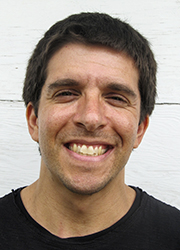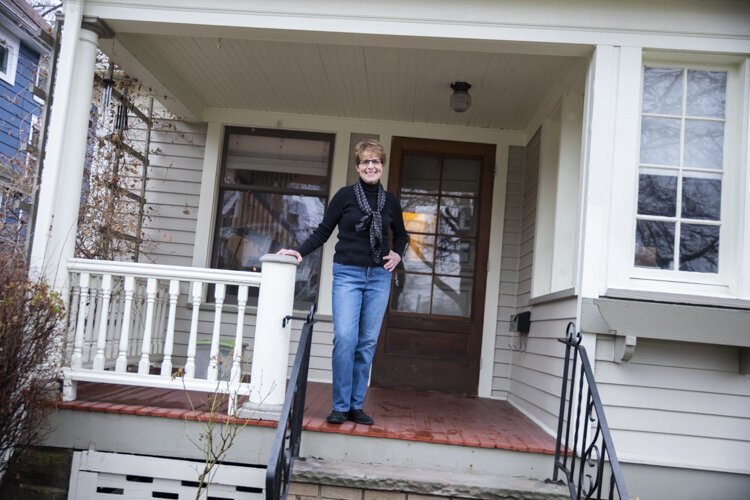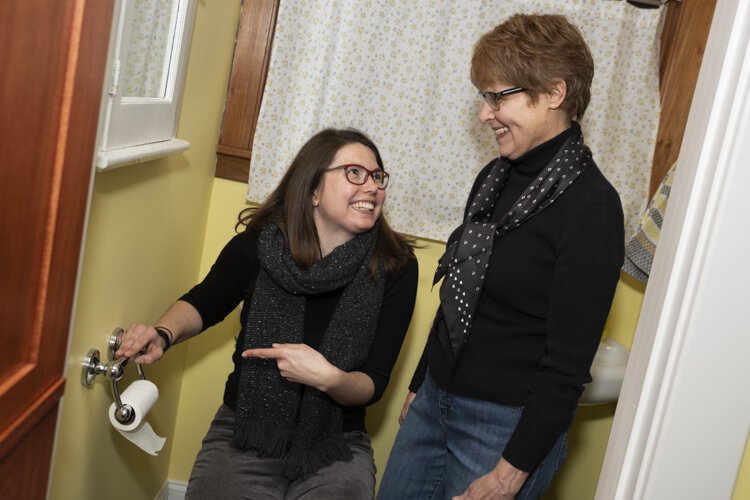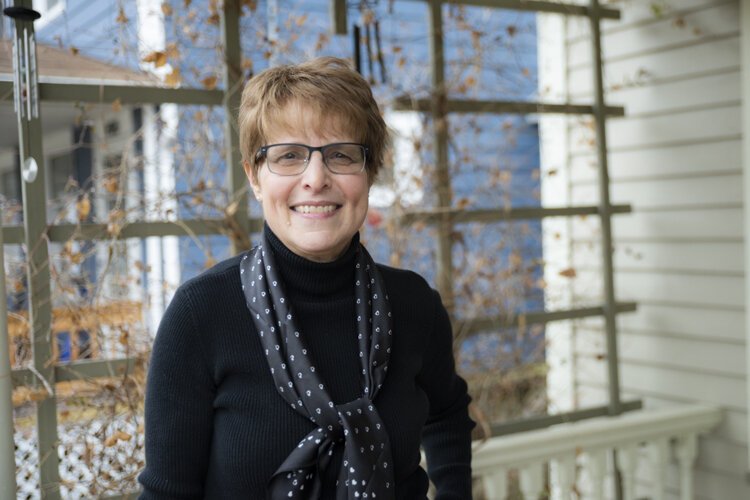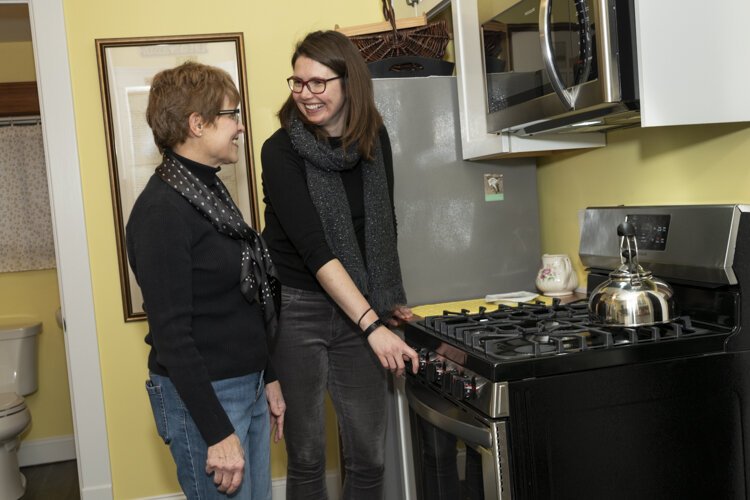Safe at home: Suburban programs bring aging-in-place options to Cuyahoga County seniors
Lakewood resident Joan Tropf has two words to describe living at home well into her 60s in the community she loves.
“It rocks.”
Tropf’s happy circumstance came with hard work, both on herself and the two-floor Dutch Colonial-style house she bought in 1989. Guiding the retired paralegal on her journey is LakewoodAlive, a nonprofit helping seniors remain home via housing upkeep programming. The organization operates among a regional network of programs and services aiding a demographic that’s aging apace with 20th century housing stock often unfit for senior living.
 Joan Tropf is prepared for most any aging-in-place obstacle, like installing slide-out drawers in the kitchen.Numerous surveys show that older Americans overwhelmingly prefer to age in place. Three of four adults 50 and older want to stay in their homes and communities as they age, according to a study released in 2018 by AARP. Meanwhile, the U.S. housing market projects a “silver tsunami” of baby boomers reaching their golden years, matching U.S. Census Bureau estimates where the number of Americans age 65 and older is expected to double by 2060.
Joan Tropf is prepared for most any aging-in-place obstacle, like installing slide-out drawers in the kitchen.Numerous surveys show that older Americans overwhelmingly prefer to age in place. Three of four adults 50 and older want to stay in their homes and communities as they age, according to a study released in 2018 by AARP. Meanwhile, the U.S. housing market projects a “silver tsunami” of baby boomers reaching their golden years, matching U.S. Census Bureau estimates where the number of Americans age 65 and older is expected to double by 2060.
Groups like LakewoodAlive—with essential assistance from civic partners—are providing in-home care to seniors as well as educating this population on keeping their residences safe, navigable and affordable.
“We’re dealing with century-old housing stock, so we searched out best practices for people to stay home safer,” says Allison Urbanek, LakewoodAlive's housing and internal operations director. “We’ve worked with folks who have portable commodes in their living rooms, or are an elderly couple trying to take care of each other, which can be difficult. Our end goal is to offer simple solutions to these situations.”
An ounce of prevention
Alongside promotion of local businesses and community events, LakewoodAlive partners with residents on home maintenance and code compliance, a service launched in 2009 in response to the foreclosure crisis. Housing workshop programs are available to the general public, with low-income owners gaining access to home repair loans. In 2017, the organization started performing on-site evaluations for a senior population concerned about older homes unkind to those with limited mobility.
“Lakewood’s housing stock is vertical,” Urbanek says. “There’s no bathrooms on the first floor, and most bedrooms are on the second floor.”
The free aging in place assessments are designed to tackle these issues. Trained LakewoodAlive staff—including Urbanek—evaluate daily routines of older homeowners, suggesting a bathroom grab rail here or a lower kitchen counter there. Wireless motion-sensing lights may prevent a nasty spill, while high toilets provide seniors comfort and accessibility.
 Allison Urbanek, Housing & Internal Operations Director for LakewoodAliveThe program has served 35 to 40 residents through education and one-on-one consultation since inception. Getting in the door can be challenging, particularly with residents who don’t believe they need a hand, Urbanek says.
Allison Urbanek, Housing & Internal Operations Director for LakewoodAliveThe program has served 35 to 40 residents through education and one-on-one consultation since inception. Getting in the door can be challenging, particularly with residents who don’t believe they need a hand, Urbanek says.
“I’m not going to sugarcoat it; it’s harder than I thought to get people to do assessments,” says Urbanek. “We’re strangers coming in, and they want to be left alone. The idea is to help people make proactive decisions, so when something changes in your house, you’ll be ready for it.”
Tropf of Lakewood loves being independent, a trait that doesn’t preclude relying on a little outside support. The self-proclaimed “girl scout” is prepared for most any aging-in-place obstacle, whether it’s replacing door knobs with easy-to-grip handles or installing slide-out drawers in the kitchen.
“I’m based in reality,” says Tropf, 66. “I keep telling people I’m on a 20-year plan in this house. I remember what it felt like to be 40, 50, and the physical changes after 60. I don’t have the energy I once did, and I’m not ignoring that. I’m lucky to have lived this long, but how can I still thrive and be a contributing member to the community?”
Asking the tough questions
The U.S. Centers for Disease Control and Prevention defines aging in place as "the ability to live in one's own home and community safely, independently, and comfortably, regardless of age, income, or ability level."
The term “aging in place” can be confusing to seniors—not to mention belittling—says David Brock, education and outreach coordinator of Home Repair Resource Center in Cleveland Heights. Through the center, seniors can apply for home modification financial assistance and undergo inspections to analyze their renovation needs.
The resource center operates, in part, under principles of universal design, which incorporates stepless entryways, wider doorways, lever-style door handles, grab bars in bath areas, and other features that improve ease and convenience. Ideally, the end product is an attractive space that people of all ability levels can enjoy.
“Sitting down and making a plan isn’t something you’re thinking about in your 40s or 50s,” says Brock. “The first question you want to ask is, do I want to stay in this home? Can I afford to stay, and from a mobility standpoint, how long can I stay?”
Changing a home’s interior structure—for example, widening doorways for easier wheelchair access —is a costly proposition. However, inexpensive alternatives such as nonskid rugs, motion-sensing lights and iPhones are a simpler means of aging happily at home.
Technology can play a crucial role in helping us age well, Brock says. Amazon Echo devices can serve as an electronic assistant, giving users medication reminders or verbal to-do lists. The gadgets also have a night-light feature and can be programmed to track down a misplaced cell phone.
“It’s common sense in a lot of ways,” Brock says of senior-friendly home improvements. “Motion lights are inexpensive and last a long time, so you won’t need to get on a ladder to change them.”
Numerous Cleveland suburbs are touting quality-of-life amenities for aging in place, be it availability of affordable homes with first-floor bedrooms, or easy access to quality medical care and local shopping. Brooklyn offers snow plowing for seniors, along with exercise classes and application assistance for HEAP and other programs. Parma stay-at-home services incorporate grass-cutting, furnace inspection and handicap ramp installation.
The city of Bedford’s aging mastery program promotes senior well-being through health care advice, group exercise and relationship development. In partnership with the Benjamin Rose Institute on Aging, the six-week program from Bedford’s parks and recreation department includes a financial education workshop and expert advice on beneficial health behaviors.
“Safely remaining in the home is ideal for seniors, whether it’s making the house physically safe, or having that exercise piece, or access to transportation and social components,” says Michael Callahan, parks and recreation assistant director. “All of these things will help people age where they are for the longest.”
Would-be girl scout Tropf is living her best life, working out at the local Y, visiting neighbors, playing piano and walking to nearby amenities on Detroit Avenue. Education and preparation have gotten her where she is, a self-sufficiency she wouldn’t trade in for anything.
“I feel like a pioneer woman able to take care of myself in the senior wilderness,” Tropf says. “Independence is tantalizing to me.”
The series is made possible through the support of Citizens Bank, the First Suburbs Consortium, and the First Ring Schools Collaborative.
